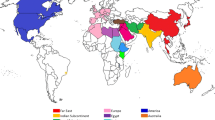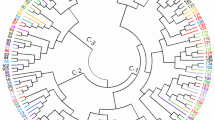Abstract
The extent of genetic diversity among 494 oil palms from 49 populations (representing ten African countries, three breeding materials, and one semi-wild material) were assessed using 16 SSR markers. The genetic diversity was high with a total of 209 alleles detected accounting for an average of 13.1 alleles per locus and a mean expected heterozygosity of 0.644. The average genetic distance among accessions was 0.769, varying from 0.000 to 1.000. Both principal coordinates analysis and neighbor joining tree, confirmed by structure analysis, clustered the entire collections into three groups: the Extreme West Africa (EWA) group (collections from Senegal, Guinea, and Sierra Leone), the West, Central, and East Africa (WCEA) group (collections from Ghana, Nigeria, Cameroon, Zaire, Angola, Tanzania, Bahia, the semi-wild material and the two Deli breeding materials) and the Madagascar group (collections uniquely from Madagascar). Madagascar populations were found to be genetically distinct from all other African populations. The influence of human and environmental factors might have played a major role in grouping the African natural oil palm into three different groups as well as in the formation of a transition zone (formed by Ghana and Côte d’Ivoire). Further analysis of genetic structure revealed Deli materials as a distinct population within the WCEA group. Given the fact that accessions were exchanged between the EWA and WCEA groups, intra- and inter-group combinations for breeding should be based mainly on the genetic distance between accessions to increase yield and heterosis.




Similar content being viewed by others
References
Amiruddin MD, Kushairi A, Rajanaidu N, Noh A, Isa ZA (2005) Performance of various oil palm introgressed populations at MPOB. Proceedings of the international conference on technological breakthroughs and commercialization—the way forward. Malaysian Palm Oil Board, Petaling Jaya, pp 111–143
Bakoumé C, Wickneswari R, Rajanaidu N, Kushairi A, Amblard P, Billotte N (2007) Allelic diversity of natural oil palm (Elaeis guineensis Jacq.) populations detected by microsatellite markers: implications for conservation. Plant Genet Resour C&U 5:104–107
Barcelos E, Amblard P, Berthaud J, Seguin M (2002) Genetic diversity and relationship in American and African oil palm as revealed by RFLP and AFLP molecular markers. Pesqui Agropecu Bras 37:1105–1114
Billotte N, Risterucci AM, Barcelos E, Noyer L, Amblard P, Baurens FC (2001) Development, characterization, and across-taxa utility of oil palm (Elaeis guineensis Jacq.) microsatellite markers. Genome 44:413–425
Billotte N, Marseillac N, Risterucci AM, Adon B, Brottier P, Baurens FC, Singh R, Herrán A, Asmady Billot C, Amblard P, Durand-Gasselin T, Courtois B, Asmono D, Cheah SC, Rohde W, Ritter E, Charrier A (2005) Microsatellite-based high density linkage map in oil palm (Elaeis guineensis Jacq.). Theor Appl Genet 110:754–765
Bruford MW, Cheesman DJ, Coote T, Green AA, Haines SA, O’Ryan C, Williams TR (1996) Microsatellites and their application to conservation genetics. In: Smith TB, Wayne RK (eds) Molecular genetic approaches in conservation. Oxford University Press, Oxford, pp 278–297
Cao TV (1995) Organisation de la variabilité génétique chez le palmier à huile Elaeis guineensis Jacq. Conséquences pour l’amélioration des populations et la création variétale. Ph.D. thesis, Institut National Agronomique, Paris
Cochard B, Adon B, Rekima S, Billotte N, De Chenon RD, Koutou A, Nouy B, Omoré A, Purba AR, Glazsmann JC, Noyer JL (2009) Geographic and genetic structure of African oil palm diversity suggests new approaches to breeding. Tree Gen Genom 5:493–504
Corley RHV, Tinker PB (2003) The oil palm, 4th edn. Blackwell Science Ltd, Oxford
Creste S, Tulmann N, Figueira A (2001) Detection of single sequence repeat polymorphism in denaturing polyacrylamide sequencing gels by silver staining. Plant Mol Biol Rep 19:200–306
Crow JF, Kimura M (1970) An introduction to population genetic theory. Harper and Row, New York
Doyle J, Doyle L (1990) Isolation of plant DNA from fresh tissue. Focus 12:13–15
Gascon JP, Noiret JM, Meunier J (1969) Effets de la consanguinité chez Elaeis guineensis Jacq. Oleagineux 24:603–607
Ghesquiere M (1985) Enzyme polymorphism in oil palm (Elaeis guineensis Jacq.). II. Variability and genetic structure of seven origins of oil palm. Oleagineux 40:529–540
Hartley CWS (1988) The oil palm, 2nd edn. Longman, London
Hayati A, Wickneswari R, Maizura I, Rajanaidu N (2004) Genetic diversity of oil palm (Elaeis guineensis Jacq.) germplasm collections from Africa: implications for improvement and conservation of genetic resources. Theor Appl Genet 108:1274–1284
Klug WS, Cummings MR (1991) Concepts of genetics, 3rd edn. Macmillan, Upper Saddle River, New Jersey
Kularatne RS (2000) Assessment of genetic diversity in natural oil palm (Elaeis guineensis Jacq.) using amplified fragment length polymorphism markers. Ph.D. Thesis, Universiti Kebangsaan Malaysia, Bangi, Malaysia
Kushairi A, Rajanaidu N, Mohd Din A (2003) Mining the germplasm. In: Seminar on the progress of oil palm breeding and selection, Medan, Sumatra
Liu K, Muse SV (2005) Powermarker: integrated analysis environment for genetic analysis. Bioinformatics 21:2128–2129
Maizura I, Rajanaidu N, Zakri AH, Cheah SC (2006) Assessment of genetic diversity in oil palm (Elaeis guineensis Jacq.) using restriction fragment length polymorphism (RFLP). Genet Res Crop Evol 53:187–195
Marshall DR, Brown AHD (1975) Optimum sampling strategy in genetic conservation. In: Frankel OH, Hawkes JG (eds) Crop genetic resources for today and tomorrow. Cambridge University Press, London, pp 53–80
Mezui MRA, Tchouamo IR, Baudouin M (2013) Adoption of the tenera hybrid of oil palm (Elaeis guineensis Jacquin) among smallholder farmers in Cameroon. Tropicultura 31:103–109
Mondini L, Noorani A, Pagnotta MA (2009) Assessing plant genetic diversity by molecular tools. Diversity 1:19–35
Moretzsohn MC, Ferreira MA, Amaral ZPS, Coelho PJA, Grattapaglia D (2002) Genetic diversity of Brazilian oil palm (Elaeis oleifera H.B.K.) germplasm collected in the Amazon Forest. Euphytica 124:35–45
Muniran F, Bhore SJ, Shah FH (2008) Micropropagation of Elaeis guineensis Jacq. “Dura”: comparison of three basal media for efficient regeneration. Indian J Exp Biol 46:79–82
Nei M (1978) Estimation of average heterozygosity and genetic distance from a small number of individuals. Genetics 89:583–590
Nei M, Takezaki N (1983) Estimation of genetic distances and phylogenetic trees from DNA analysis. Proc 5th World Congr Genet Appl Livest Prod 21:405–412
Noiret JM, Gascon JP, Bénard G (1966) Contribution à l’étude de l’hérédité des caractéristiques de la qualité du régime et du fruit d’Elaeis guineensis Jacq. Oleagineux 21:343–349
Perrier X, Jacquemoud-Collet JP (2006) DARwin software. http://darwin.cirad.fr/darwin
Pritchard JK, Stephens M, Donnelly P (2000) Inference of population structure using multilocus genotype data. Genetics 155:945–959
Rajanaidu N (1994) PORIM oil palm gene bank. Palm Oil Research Institute, Bangi, Malaysia
Rajanaidu N (1995) PORIM oil palm genebank. Palm Oil Tech Bull 1:7
Rajanaidu N, Jalani BS (1994) Oil palm genetic resources collection, evaluation, utilization and conservation. In: PORIM Colloquium on Oil Palm Genetic Resources. PORIM, Bangi, Malaysia
Rajanaidu N, Maizuram I, Cheah SC (2000) Screening of oil palm natural populations using RAPD and RFLP molecular markers. In: Rajanaidu N, Ariffin D (eds) Proceedings of international symposium on oil palm genetic resources and utilization, Kuala Lumpur, pp AA1–AA28
Rajanaidu N, Kushairi A, Rafii M, Mohd Din A, Maizura I, Isa ZA, Jalani BS (2000a) Oil palm genetic resources and their utilization: A review. In: Rajanaidu N, Ariffin D (eds) Proceedings of international symposium on oil palm genetic resources and utilization, Kuala Lumpur, pp A1–A55
Saghai Maroof MA, Biyashev RM, Yang GP, Zhang Q, Allard RW (1994) Extraordinary polymorphic microsatellite DNA in barley: species diversity, chromosomal locations, and population dynamics. Proc Natl Acad Sci USA 91:5466–5470
Shah FH, Rashid O, Simons AJ, Dunsdon A (1994) The utility of RAPD markers for the determination of genetic variation in oil palm (Elaeis guineensis). Theor Appl Genet 89:713–718
Singh R, Zaki NM, Ting NC, Rosli R, Tan SG, Low ETL, Ithnin M, Cheah SC (2008) Exploiting an oil palm EST database for the development of gene-derived SSR markers and their exploitation for assessment of genetic diversity. Biologia 63:227–235
Ting NC, Noorhariza MZ, Rozana R, Low ETL, Ithnin M, Cheah SC, Tan SG, Singh R (2010) SSR mining in oil palm EST database: application in oil palm germplasm diversity studies. J Genet 89:135–145
Yeh FC, Boyle T (1999) POPGENE Version 1.32. The user-friendly software for population genetic analysis. University of Alberta and CIFOR, Calgary, Alta
Zane L, Bargelloni L, Patarnello T (2002) Strategies for microsatellite isolation: a review. Mol Ecol 11:1–16
Zeven AC (1967) The semi-wild oil palm and its industry in Africa. Agric. Res. Rep. no. 698
Zulkifli Y, Maizura I, Rajinder S (2012) Evaluation of MPOB oil palm germplasm (Elaeis guineensis) populations using EST- SSR. J Oil Palm Res 24:1368–1377
Acknowledgments
The present study was carried out in the Plant Genetics Laboratory of Universiti Kebangsaan Malaysia (UKM) with the joint support of the Malaysian Palm Oil Board (MPOB) in Malaysia, the Centre de Coopération Internationale de Recherche Agronomique pour le Développement (CIRAD) in France, and the Institute of Agricultural Research for Development (IRAD) in Cameroon. Our sincere thanks to Alena Sanusi for helpful comments on the manuscript.
Author information
Authors and Affiliations
Corresponding author
Rights and permissions
About this article
Cite this article
Bakoumé, C., Wickneswari, R., Siju, S. et al. Genetic diversity of the world’s largest oil palm (Elaeis guineensis Jacq.) field genebank accessions using microsatellite markers. Genet Resour Crop Evol 62, 349–360 (2015). https://doi.org/10.1007/s10722-014-0156-8
Received:
Accepted:
Published:
Issue Date:
DOI: https://doi.org/10.1007/s10722-014-0156-8




